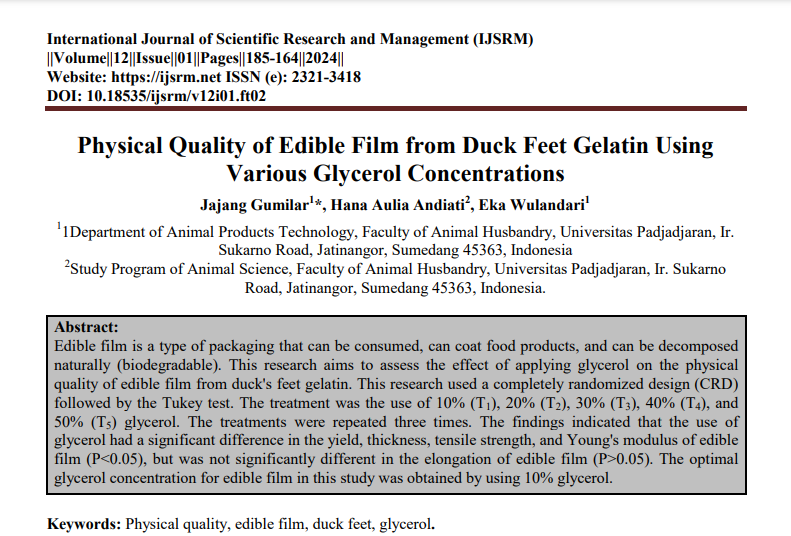
Submission to VIJ 2024-01-27
Keywords
- Physical quality, edible film, duck feet, glycerol
Copyright (c) 2024 Jajang Gumilar, Hana Aulia Andiati, Eka Wulandari

This work is licensed under a Creative Commons Attribution 4.0 International License.
Abstract
Edible film is a type of packaging that can be consumed, can coat food products, and can be decomposed naturally (biodegradable). This research aims to assess the effect of applying glycerol on the physical quality of edible film from duck's feet gelatin. This research used a completely randomized design (CRD) followed by the Tukey test. The treatment was the use of 10% (T1), 20% (T2), 30% (T3), 40% (T4), and 50% (T5) glycerol. The treatments were repeated three times. The findings indicated that the use of glycerol had a significant difference in the yield, thickness, tensile strength, and Young's modulus of edible film (P<0.05), but was not significantly different in the elongation of edible film (P>0.05). The optimal glycerol concentration for edible film in this study was obtained by using 10% glycerol.
References
- Abdullah, M. S. P., M. I. Noordin, S. I. M. Ismail, S. Nyamathulla, M. Jasamai, L. K. Wai, N. M. Mustapha, dan A. F. Shamsuddin. 2016. Physicochemical Evaluation and Spectroscopic Characterisation of Gelatine from Shank and Toes of Gallus gallus domesticus. Sains Malaysiana. 45(3): 435-449.
- Anandito, R. B. K., Edhi, N., Akhmad, B. 2012. Effect of Glycerol on the Characteristics of Edible Film Made from Jali Flour (Coix lacryma-jobi L.). Journal of Agricultural Products Technology. 5(2) 17-23.
- Bonnardeaux, J. O. H. N. 2006. Glycerin Overview. Department of Agriculture and Food: Western Australia.
- Chambi, H. dan C. Grosso. 2006. Edible Film Produced with Gelatin and Casein Cross-linked with Transgluminase. International Journal Food Res. 39: 458-466.
- Cerqueira, M. A., A. I. Bourbon, A. C. Pinheiro, J. T. Martins, B. W. S. Souza, J. A. Teixeira, dan A. A. Vicente. 2011. Galactomannans use in the Development of Edible Films/ Coatings for Food Applications. Trends in Food Science and Technology. 22(12): 662-671.
- Fatma, R. Malaka, dan M. Taufik. 2015. Characteristics of Edible Film Made from Dangke Whey and Agar Using Glycerol with Different Percentages. Journal of Animal Science and Technology. 4(2): 63-69.
- Fera, M., dan Nurkholik. 2018Physical Quality of Edible Film Produced from a Combination of Sheepskin Gelatin and Agar (Gracilaria sp). Journal Food and Life Sciences. 2(1): 45–56.
- Gela, D. T. 2016. Characteristics of Edible Film from Horsehide Gelatin (Equus caballus) and its Application for Food Packaging. Faculty of Science and Technology. Alauddin State Islamic University. Makassar. Indonesia.
- Jacoeb, M. Agoes, Nugraha, Roni, Utari, dan P. S. D. Siluh. 2014. Production of Edible Film from Linduk Fruit Starch with the Addition of Glycerol and Carrageenan. JPHPI. 17(1): 14-21.
- Japanesse Industrial Standard. 1975. Japanese Standards Association. 2(1707).
- Kokoszka, S. dan A. Lenart. 2007. Edible Coatings-Formation, Characteristics and use-a Review. Polish J. Food Nutr. Sci. 57: 399-404.
- Laila, U. 2008. Effect of Plasticizer and Drying Temperature on the Mechanical Properties of Edible Film from Chitosan. Food and Bioprocess Engineering Laboratory Research Report. Department of Chemical Engineering, Faculty of Engineering. UGM. Yogyakarta. Indonesia.
- Miwada, IN. S., I. N. Simpen, M. Hartawan, A. W. Puger, dan N. L. P. Sriyani. 2015. Characteristics of Gelatin from Livestock Foot Skin and Its Potential as Edible Film. Animal Husbandry Scientific Magazine 18(3): 109 – 113.
- Novian W. A., C. B. Handayani, Afriyanti. 2018. Physical Characteristics of Edible Film from Chicken Bone Waste Gelatin with Different Plasticizer Concentrations, National Seminar, Faculty of Agriculture.
- Poeloengasih, C.D, dan Marseno, D.W. 2003. Characterization of Edible Film Composite Protein from Winged Bean Seeds and Tapioca. Journal of Food Technology and Industry. 14(3): 224-230.
- Purnomo, E. 1992. Penyamakan Kulit Kaki Ayam. Kanisius Publisher. Yogyakarta. Indonesia.
- Setiani, W., T. Sudiarti, dan L. Rahmidar. 2013. Preparation and Characterization of Edible Film from Pati Sukun-Chitosan Polyblend. Journal of Valence Chemistry.3(2): 100-109.
- Qiu-Ping Zhong and Wen-Shui Xia. 2008. Physicochemical Properties of Edible film and Preservative Film from Chitosan/ Cassava/ Starch/ Gelatin Blend Plasticized with Glycerol. J. Food Technol. Biotechnol 46(3): 262-269.
- Swaidatul, M. A., Widodo, dan W. Sri. 2016. Natural Mask Formulation Based on Jicama and Black Cumin to Reduce Wrinkles on Facial Skin. Care Journal. 4(2): 22-35.
- Tapia-Blacido, D., P.J. Sobral, and F.C.Menegalli. 2005. Development and Characterization of Biofilms Based on Amaranth Flour (Amaranthus Caudatus). J.Food Engineering. (67): 215-223.
- Vieira, M. G. A., M. A. Da Silva, L. O. Dos Santos, and M. M. Beppu. 2011. Natural-Based Plasticizers and Biopolymer Films: A Review. European Polymer Journal. 47: 254-263.
- Wittaya, T. 2012. Protein-Based Edible Films: Characteristics and Improvement of Properties. Chapter 3. Intech Open Science 43-70.
- Wiset, L., Poomsa-ad, N., and Jomlapeeratikul, P. 2014. Effects of Drying Temperatures and Glycerol Concentrations on Properties of Edible Ilm from Konjac Lour. Journal of Medical and Bioengineering. 3(3): 171-174.
- Wulandari, D. 2016. Making Edible Film from Split Cowhide Gelatin with Added Glycerol Levels. Periodical Research on Leather, Shoe and Leather Product Technology 15(1).
- Yang, L., dan A. T. Paulson. 2000. Effects of Lipids on Mechanical and Moisture Barrier Properties of Edible Gellan Film. Food Research International. 33(7): 571-578.